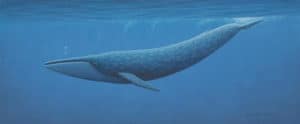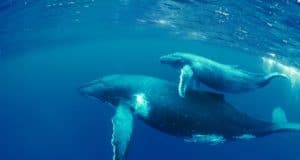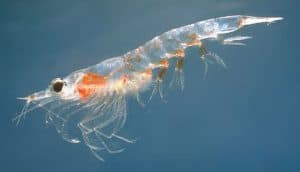Blue whales is one of the biggest animal on the earth, and doesn’t have any natural predator like another animal. Eh, really? How can? Blue whales is bigger than dinosaurs, and their heart is big as small car. They can eat up to 4 tonnes krills each days. What do you think when hear all of those? And how do you think how amazing is big whale? We know you already curious about further information about blue whales, like: what physical features they have, what kind of animal become their feed, where they live, or how long they can live. So here we go, some unique facts about amazing blue whales!
Read also:
Facts about Blue Whales

First of all, we gonna start it from their looks. Why its become first thing? Of course its very important to know what exactly blue whales looks like, because its very different from another creatures! And the first thing is: Blue whale is the largest mammal and possibly the largest animal on the earth! Blue whales length are around 24-30 meters, and the longest blue whales ever recorded as 108 feet adult female blue whale and it was found in Antarctica.
Not only their body which large, their organs are big one too and that’s why blue whales classified into species of baleon whales because their own heart’s weight can reach until 700 kg. Their heart is heavy as a small car! Usually, length of female blue whales is 10 meters longer than the male one.
Even their body is really big one, their spin isn’t really big one too because length of the spin only one foot, and only about 12% of total body length. Oh don’t forget about their tail too because its very tall and straight, and can reach until 20 feet high. Blue whales use their tails to dive deeply and bringing them to surface of the water, and with their tail they can dive until 200 meters down.
Blue whales also has 55-68 ventral grooves from he lower jaw to near the novel. Their bubblers is one of the most important part of their body because can make their body always be warm under water. Blue whales also included another animals into their family, such as: humpback whales, fin whales, bryde’s whales, sea whales, and minkle whales. Blue whales are at the top of the food chain and that’s why they have important role in he overall health of the marine environment.
1. Unique color
First Facts of Blue Whales is their unique colors. Blue whales color isn’t really blue. Really? So why they called as “blue whales”? Holding on, we haven’t reach the point yet. Their color isn’t really blue one because their color actually is blue one with grey dotted, with light-grey or yellow-white in under their body. Their belly usually look pale and sometime white, while their head of blue whale is very long and big like the quarter of their body. Blue whales also called as sulfur-bottom whales because of the yellowish color underside their body which come from algae who live in their body. So, its still blue with another unique features, right?
2. High-toned voice
Another uniqueness from this blue whale is their voice. Blue whale’s voice is clammed as the loudest among another animal in the sea because their decibels reach until 188, and its louder than jet’s engine which only 140 decibels. Blue whales usually will use their voice especially in breeding seasons.
3. Distribution and migration
Before 20th century, they were like 250,000 blue whales live freely in the sea without worrying about dangers in the ocean ecosystems. Blue whales can be found in every ocean of the world, like: Pacific, Atlantic, Indian, and Southern Ocean. Blue whales easily to found in Australia, where they’re part of more or less continues distribution from Tasmania to Indonesia. Its also easily to found in equaterial Indian Ocean, such as Sri Lanka and Maldives. Blue whales sometime also appear at the gulf of St. Lawrence and coasts of Monterey, California, and Baja California. Blue whale isnt live into group, so we can see them swimming in pairs or in small group, which only consist of 2-3 whales. They usually travels with singing too, so another blue whales who hundreds miles away can be warn if theres any danger around them.
Read also:
Blue whales also do migration from one place into another place and they do that twice in whole year. They usually do that when summer come, and that’s mean they need cooler water for found some food. And when winter come, they will do immigration too for getting a warmer water because its time for breeding season! Summer is feeding season for blue whales, that’s means blue whales will really lot small creatures, which we usually called them as krill. And it will be very different when winter comes and when they start their journey because blue whales don’t need something to eat for at least one month and depending from their body for some energy to move. Blue whales will stop their journey every 200-500 kilometers to eat something between that and they will continue that again until they arrived in food-rich areas where they will get so much food to sustain themselves for the rest of the year.
4. Types of Blue Whales
Next Facts of Blue Whales is their types. Blue whales can classified into three types, which are: Northern blue whales and Southern blue whales (both characteristic are same) and Pygymy blue whales, which their average length is about 24 m. Pygmy blue whales is another type of blue whales which first identified in 1966. Unique appearance from this one is they have larger head, shorter tail, and shorter baleen compared to antoher type. Their larger head and shorter tails gives this whales badpole like shape. Length of this pygmy is smaller than blue whales, which its only 10 feet.
Pygmy blue whales can be found easily in tropical waters, throughout in the Indian and South Pacific Oceans and they spending their breeding seasons and in South Atlantic Ocean for their feeding seasons. Like another one, pygymy blue whales also communicate using loud-pitched sounds that can be heard miles away and they produce the sound to attract their partner while breeding seasons. Their common threat is water pollution, such as: oil spills, garbage, and another human factors like noise pollution, explosives and boating equipment, also over fishing. Pygymy blue whales will reach their sexual maturity in 10 years age and their length only around 19,2 meters and weights about 52,2 tonnes.
5. Long life span
Another unique facts from whale is their growth rate is pretty amazing and classified as fastest one in animal kingdom especially in the sea! Blue whales reach their sex maturity in 5-10 years and can reproduce every 2-3 years.
6. Pregnancy
Female blue whales pregnancy is about 10-11 months, and they don’t eat to much or not eat anything at all until their baby until reach their first year. Blue females usually only have one young baby, and its very rare to have twins.
Baby Blue Whales

Baby blue whale also born into huge one, and their length can until 8 m and their weight is about 3,3 tonnes. Every single days, this baby whale will need until 500 liters milk from their and they will stop suckle after 7-8 months. Baby blue whale can gain weight until 90 kg because they also eat so much krill.
Baby blue whales can gain 10 pounds every hour, and thats means they gain 200 pound every day! When the baby already reach 6 months old, they will start eat small shrimp.
The new born instictively swims to the surface within 10 seconds for their first breath, and its helped by their mother using her flippers. In 30 mins, baby whale already can swim.
7. Dont have any natural predators
Because of their big size, blue whales don’t have any natural predators in the ocean. Its does happen too for young blue whales, even they look vulnerable but no one will attack them and that’s why ocean is the safest place in the world for them. Predators of blue whales is only human, because they do over exploitation to blue whales population and start hunting them since 1800’s and escalated quickly in 1900’s. People usually hunts blue whale for their meat and bubbler.
8. Friendly to human
one of Facts of Blue Whales that you didn’t know is friendly. Blue whales couldn’t eat human even they wanted too because they doesn’t have any teeth to chew meat up. It doesn’t mean if blue whales also very tame, because when baby blue whales being threatened too, their mother will be angry and it would be start attack the doer.
9. Krill, the primary food

Blue whales can consuming 4 tonnes krills each day, which mean they need up to 40 million krills each month. Beside krills, blue whales usually eats custaceans along with some occasional small fish.
In summer, blue whales are able to eat until six tonnes every day from everything in their environment. Even they eat really a lot during summer, it will be really different when they do migrate to another place during winter because they barely eat anything at all.
Krill is primary food of blue whales with scientific name is euphausia superba. Krill have black eyes and transparent body, thus their shells have bright red color from the pigment. Adult Antarctic krill body is very small, its only 6 cms in length and weight over a gram. Antarctic krill population is very rich, its about 500 million tones in the Southern Ocean. This over abundant population maybe classified as the largest multi-cellular animal species on the world.
Most of the time, krill will stay deep in the water and come into surface only in nights. Human also can do commercial fishing to krill and its already began around 1970s. Antarctic krills are belong to herbivorous because they mostly eat phytoplankton or some plankonic animals in Southern Ocean. It will be different in winter because they also has another things to eat, such as: algae which grown underside of flat ice, detritus on sea floor, or another animal in the water. Antartic krill can survive until 200 days without eat anything and thats why they have a long time period. Not only eaten by whales, Antarctic krill also become primary food for seals, sea birds, fish and squid, and another creature in the sea.
10. Great diver but slow one
Blue whales are classified into slow swimmer but they can swim until 30 km/h when they’re in dangerous situation. When they start diving, they will blow frequently like every 10-20 seconds for 2-6 minutes then diving again for 5-20 minutes. Blue whales usually do short dive for every 10-20 minutes even they can diving 30 minutes. Blue whales usually can be found during in good weathers and in considerable distance because they usually swim up to 12 heights of their powerful blows. Every 10-20 minutes, blue whales will go diving so they can get their food and its only about 100 meters deep feet.
11. Major threats
Like another species, blue whales can be endangered too by human factors, such as: chemical and sound pollution, over fishing of krill so blue whales don’t get enough food, lose their habitat, become entangled in fishing gear, or climate change because global warming is really happened. Climate change can causes their frontal zone move further so its means it will bring large amount of nutrients further and they will need go further to reach that place.
Read also:
12. Banned to be haunting
Last Facts of Blue Whales is hunting banned label. Hundred years ago, blue whales population is about 200,000 individuals but it was decrease day by day because they hunted. Blue whales usually haunted for their meats, oils, and another body parts because they’re so much valuable and can be sell in high price. Today, blue whales classified into endangered one by IUCN because it less than 20,000 individuals left in the world. Even they’re not already hunted again by human, blue whales often threatened by accidents with ships.
Read also:
People are banned for hunting blue whales since 1966 because their population was already too much decrease, but sometime its still possible to found blue whales turn into any dish in Japan. To make people aware about blue whale and how important them into our life, some organization and government from many countries in the world wide start campaign about this, make museum, or we can see trip operation blue whales in some areas, such as: Iceland, Canada, California, Srilanka, Maldives, and Australia.
Because blue whales already categorized to endangered one, its already protected by law and not having been deliberately caught since 1970’s, beside their population keep decrease from their natural range.
Read also:
And thats it, some incredible facts about blue whales. We have to remember to keep our environment as clean one, especially for ocean environment because theres so much species inside them and have important roles for the earth. So, are you ready to keep our earth healthy? Start the change from yourself!